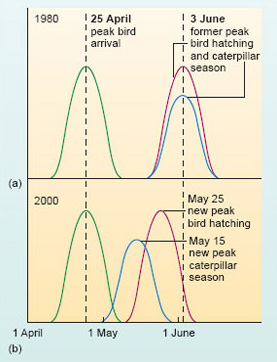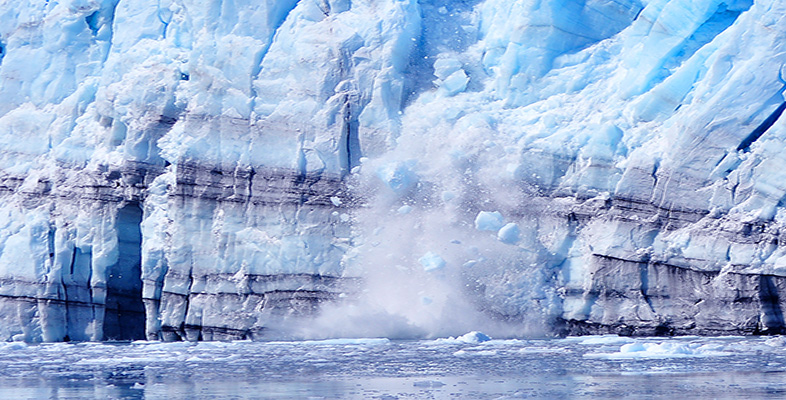2.5.2 Environmental indicators
The notion of a link between climatic conditions and the behaviour of plants and animals (e.g. the growth of trees or coral) and the composition of natural communities or ecosystems (the type of vegetation in a given area, say) is fundamental to the use of proxy data to reconstruct past climates. Some examples of biological responses to recent climate change were included in Box 9. Here we should be wary of jumping to conclusions. Such changes involve complex living systems that can respond in complicated ways to a great variety of other pressures. Particular caution is necessary wherever records are of short duration, which in this context means less than a few decades.
Well aware of this stricture, and having conducted a literature survey of papers documenting biological and ecosystem changes on this sort of time-scale, the IPCC concluded (with high confidence) that the following observations are related to recent climate change:
earlier flowering of plants, budding of trees, emergence of insects and egg-laying in birds and amphibians;
lengthening of the growing season in mid- to high latitudes;
shifts of plant and animal ranges to higher latitudes and higher altitudes;
decline of some plant and animal populations.
You may well have noticed the kind of 'phenological' changes referred to in the first two points - shifts in the timing of life cycle events in plants and animals. Many biological phenomena (e.g. leaf bud burst and flowering in plants) cannot proceed until a minimum temperature has been reached over an adequate length of time. Changes in the timing of such events are easy to observe and monitor, and can provide sensitive indicators of climate change. Studies from various regions and ecosystem types tell a consistent story. For example, from Scandinavia to the Mediterranean and across North America, the growing season for plants has increased by 1-4 weeks over the past 50 years; spring comes earlier, but leaf fall in deciduous plants is delayed. Many animal life cycles also depend on temperature; in the UK, for instance, it seems that aphids now appear on average a week earlier than 25 years ago.
Migrating animals, especially butterflies and birds, benefit from keeping pace with the changes by arriving earlier in their summer habitat, so that food such as pollen and insects is available at the right time. Many are responding in just such a manner. However, there are signs that, in some cases, important inter-dependencies may be slipping 'out of sync' as the species involved respond to changed conditions in different ways; one example is included in Figure 34.

Other plants and animals are adapting by extending their ranges - an example of the type of response referred to in the third bullet point above. Put simply, the underlying principle here is that the geographical limits of many plants and animals are determined very largely by temperature. In the Northern Hemisphere, for instance, it may be too cold for some species further north (or at higher altitudes), and too warm for other species further south (or at lower altitudes; alpine plants come to mind). Either way, shifts of the kind that appear to be underway (Box 9, points 4-6) are broadly consistent with a warmer climate.
Natural communities of plants and animals are in a constant state of change, and their composition is often strongly influenced by climatic factors. In a warmer climate, crucial interactions in the complicated dynamics of natural systems can be disrupted; some species will fare better than others. Those that are particularly sensitive to environmental change and/or unable to adapt in various ways (e.g. by colonising new areas) may suffer a decline in population (the final bullet point above), or be lost altogether (Box 9, point 5).
To sum up: the IPCC TAR is confident that a large proportion (over 80%) of the observed changes in these environmental indicators are in the direction consistent with well-established temperature relationships. In other words, there is a negligible probability that they happened by chance, given what is known about the various mechanisms of change in biological systems. Taken together with all the other indicators reviewed earlier in this section, they do indeed add up to a 'collective picture of a warming world' (IPCC, 2001a). At the same time, they serve as a portent of the kinds of changes that could lie ahead.
The threat of mass extinctions and loss of biodiversity regularly hits the headlines. We shall not attempt to grapple with the complexities of this issue - another potent and contested area of the climate change debate. Bear in mind, though, that ecological systems around the world are already under siege from countless other pressures linked with human activities: loss or fragmentation of habitat due to deforestation, urban and industrial development, demand for agricultural land, etc.; air and water pollution; overfishing and marine pollution; and so on. While some species may increase in abundance or range, climate change is likely to increase existing threats to other more vulnerable species, and some may literally have nowhere to go as the world warms up. Examples include plants and animals that thrive only in the coldest parts of the planet - at high latitudes and/or high altitudes. Like the Adélie penguins of Antarctica (Box 9), the polar bears, walrus and ringed seals of the far north all depend on Arctic sea ice in one way or another.
